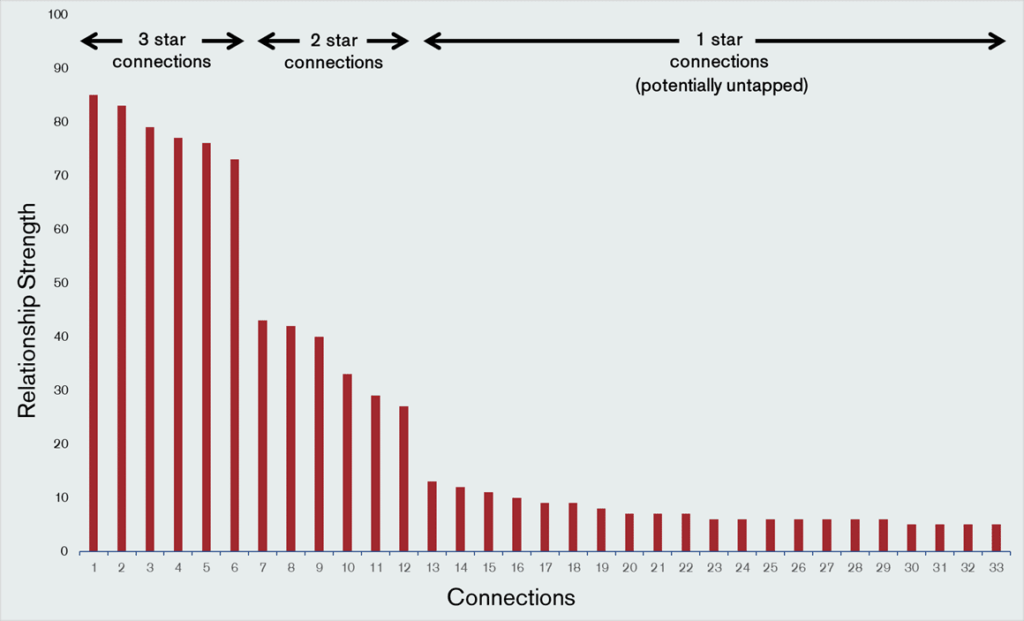Introduction
In my previous articles[1] I have discussed several aspects of treating relationships as a form of intangible asset and how these can be managed in a business context. In this article, I am going to narrow the focus to consider the importance of weak ties. There is a natural tendency to focus on the strongest links as the relationships of greatest value but this not always the case.
How do you measure the strength of connections?
In my last article (Portfolio management for relationship assets) I briefly discussed the ways a relationship could be scored in terms of its strength. To recall, first degree connections can simply be scored on a “star” rating system for identifiable connections. Externally evaluated network connections can be assessed in a more sophisticated manner by specialist relationship capital tools such as BoardEx. Such a system can calculate different tie strengths between two connected individuals based, among other things, on their relative positions in a corporate hierarchy. Indeed, the most sophisticated systems such as BoardEx allow for different relationship strengths in each direction between two people.
What are weak ties?
In both approaches, the resulting portfolio of relationships can be ranked in terms of tie strength, in a spectrum from the strongest to the weakest. With a 3-star system, for instance, clearly 3-star rankings can be considered strong, 2-star moderate and 1-star as weak ties. A different number of star ratings can be accommodated into these categories in a straightforward manner. This is illustrated in the following chart.


Calculating tie strength for externally evaluated networks results in numerical values that can be ranked from largest to smallest. In this case, the characteristics of these values can be used to sort the relationships into the three categories. Tie strength almost invariably follows a distribution that is characterized by a small number of people with high value ties, a considerable number with low value ties and a transition area in the middle[2]. From this follows an obvious classification – high value connections are clearly strong, low value ties are weak, and the ones in the middle range are of moderate strength.
Superficially, it would appear that strong ties are the most valuable, and indeed, in many contexts this is true. If you need advice that is sensitive or on an area of high importance, for instance, you will naturally rely on those you most trust. In other settings, however, this strength can surprisingly reduce the value of the connection.
Why are weak ties important?
If you have a strong relationship with two individuals there is a very high likelihood that those two people also know each other. This is such a commonplace event that has a special name, transitivity (also known as triangle formation, from the pattern made in a graph). In terms of friendships, this “sharing of friends” tendency is usually a positive effect and one which helps cement together the social group.
In business, however, there are possible downsides. One is the risk of groupthink – the tendency for a social group to agree on a course of action to maintain social cohesion even if they individually have doubts. This is a well-known phenomenon and has been thoroughly examined in business and sociology literature[3].
A greater risk is the narrowing of environmental scanning and sensitivity to new input. Take the example of looking for a job in Covid-19 times. In this case any information on new opportunities that come from the relationship network are likely to be shared among your strong relationships and so unlikely to yield an advantage in a challenging job market. It is here that the value of weak ties comes into its own. By virtue of the weakness of the tie it is unlikely that this information is available to other members of your friendship group and so gives an advantage in gaining employment[4].
This information advantage is not restricted to job seeking. The power of weak ties can be an advantage anywhere it is important to sense changes in the external environment. This includes within large organizations (understanding developments in other functions, for instance) as well as in the wider national and international economy. Indeed, the original paper by Granovetter in 1973 that describes this phenomenon[5] insists that you cannot have a widespread network without having weak ties. Weak ties allow for a wider network because it is too time and resource intensive to maintain all relationships at the same level of intensity.
What this means for business
Establishing a healthy network that includes many weak ties is crucial if a business is serious about environmental monitoring and, especially, in the early detection of business opportunities and threats. The Covid-19 crisis is just one vivid illustration of the risks of missing a major economic or political event, and the potential disastrous cost of not preparing in time. At the level of individual firms, early knowledge about new competitors, threats, rival products or opportunities can mean the difference between continued commercial success and failure.
The problem is one of knowing ahead of competitors what is coming and of having time to adapt before everyone else. This is not a new issue to any serious business, but what might be is the value that weak links can play in this process. Relying on familiar and well-established relationships may fail to give the information differential that can make all the difference. In contrast, nuggets of information from occasional and less well-known contacts may hold surprising value – particularly as you may be the only one to be apprised of this knowledge.
Indeed, many structures already exist to create and foster weak ties. These include trade fairs, conferences and seminars. It is now almost a cliché that the best part of such an event is the conversation in gatherings following the formal event. This is often the venue where new ideas and information is shared, and where new (weak) contacts are established. Conference organizers explicitly recognize this, focussing attention on organizing post-event functions and face-to-face “networking” events. The big difference between “networking” and establishing weak connections is that the value lies not in how thick a stack of business cards is collected. Weak connections are often people with whom you genuinely would like to have more contact but lack a reason to do so.
Maintaining these weak connections is not heavily resource consuming either. Some writers suggest that an annual “ping” is sufficient[6]. Modern communications tools are perfect for this purpose, particularly in an environment where face-to-face contact is not possible owing to Covid-19 restrictions. The significant risk to maintaining these weak ties is that they change jobs or employers and the connection becomes lost, thereby severing the relationship.
How can organizations take advantage of these weak links?
A greater challenge is for an organization to take advantage of these connections. As these ties are, by definition, weak they are usually not in the forefront of anybody’s mind and, as a result, will not be considered part of their relationship portfolio. Indeed, a colleague is unlikely to suggest an acquaintance that she only contacts once every year or two. And yet, these can prove to be the most valuable when there is an urgent need to gather information from or to make contact with a specific body.
This is where specialist relationship capital tools such as BoardEx can make a real difference. Operating with high quality and up-to-date information they can identify when these weak ties have changed roles. This not only keeps the connections alive but can also identify if these new roles are of significance to the firm. Network analysis can also uncover forgotten weak ties.
Importantly, such a tool can also identify the second-degree connections that pass through these weak ties. These open up opportunities for even greater contact with the external environment and the ability to collect novel information. Combining the role changes by the weak ties and by their network creates even more opportunities to gain a competitive information advantage.
It follows that the combination of the up-to-date data and network exploration capabilities of a modern relationship capital tool, aligned with the development and maintenance of weak ties by users can generate significant information advantages for organizations. This capability may prove to be a key competitive advantage given the uncertain business environment facing firms for the foreseeable future.
[1] Previously published articles.
[2] The nature of these distributions is a subject of much debate – see Scant Evidence of Power Laws Found in Real-World Networks, Quanta Magazine, February 15, 2018 (https://www.quantamagazine.org/scant-evidence-of-power-laws-found-in-real-world-networks-20180215/) for a relatively accessibly discussion of this field.
[3] See https://en.wikipedia.org/wiki/Groupthink as an introduction to the field – there is a great deal of literature on this effect.
[4] This is a well-studied example – see, for instance, https://www.forbes.com/sites/nextavenue/2016/08/17/to-get-a-job-use-your-weak-ties/
[5] Granovetter M S, 1973, The Strength of Weak Ties, American Journal of Sociology, May, Vol 78, No 6, pp 1360 – 1380. http://www.jstor.com/stable/2776392
[6] A “ping” is a test of a network connection without sending any real data. For more details see https://azzarellogroup.com/web/the-power-of-weak-connections/#.Xyu-XihKg2x
